Forest Fragmentation and Fires in the Eastern Brazilian Amazon–Maranhão State, Brazil
Abstract
1. Introduction
2. Materials and Methods
2.1. Study Area
2.2. Dataset
2.2.1. Land Use and Land Cover Data
2.2.2. Active Fires Data
2.2.3. Burned Areas Data
2.2.4. Rainfall Precipitation Data
2.2.5. Land Surface Temperature Data
2.3. Data Processing and Analysis
2.3.1. Forest Fragmentation Analysis
2.3.2. Spatial Analysis
2.3.3. Statistical Analyses
3. Results
3.1. Forest Fragmentation Dynamics between 1985 and 2017
3.2. Active Fire Dynamics between 2012 and 2017
3.3. Forest Fragmentation and Fires between 2003–2017
4. Discussion
5. Conclusions
Author Contributions
Funding
Institutional Review Board Statement
Informed Consent Statement
Data Availability Statement
Conflicts of Interest
Appendix A
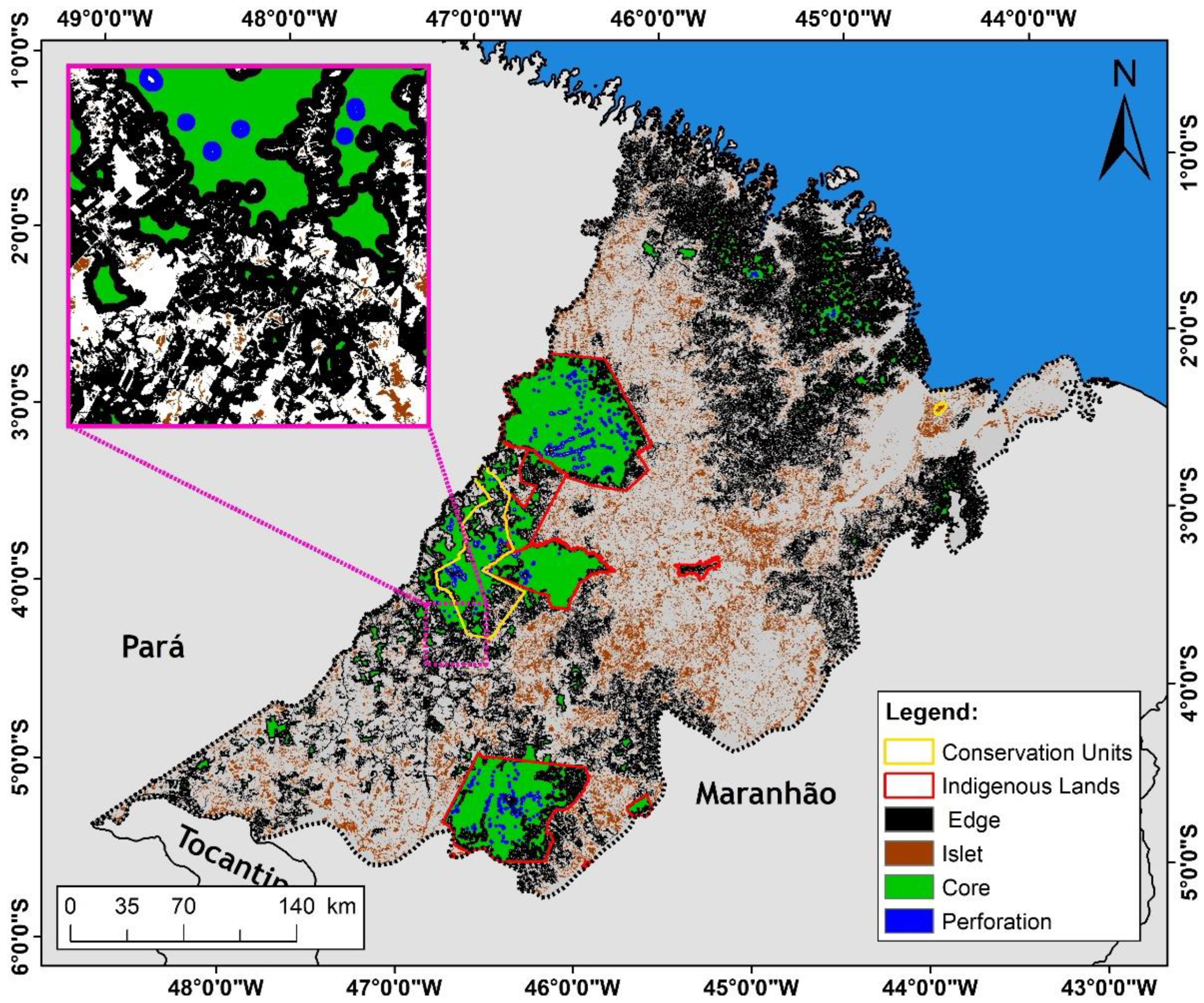
References
- Malhi, Y.; Roberts, J.T.; Betts, R.A.; Killeen, T.J.; Li, W.; Nobre, C.A. Climate Change, Deforestation, and the Fate of the Amazon. Science 2008, 319, 169–172. [Google Scholar] [CrossRef]
- Baccini, A.; Goetz, S.J.; Walker, W.S.; Laporte, N.T.; Sun, M.; Sulla-Menashe, D.; Hackler, J.; Beck, P.S.a.; Dubayah, R.; Friedl, M.A.; et al. Estimated Carbon Dioxide Emissions from Tropical Deforestation Improved by Carbon-Density Maps. Nat. Clim. Chang. 2012, 2, 182–185. [Google Scholar] [CrossRef]
- Saatchi, S.S.; Harris, N.L.; Brown, S.; Lefsky, M.; Mitchard, E.T.; Salas, W.; Zutta, B.R.; Buermann, W.; Lewis, S.L.; Hagen, S.; et al. Benchmark Map of Forest Carbon Stocks in Tropical Regions across Three Continents. Proc. Natl. Acad. Sci. USA 2011, 108, 9899–9904. [Google Scholar] [CrossRef] [PubMed]
- Aragão, L.E.O.C. Environmental Science: The Rainforest’s Water Pump. Nature 2012, 489, 217–218. [Google Scholar] [CrossRef]
- RAISG-Amazonian Network of Georeferenced Socio-Environmental Information Deforestation in the Amazonia (1970–2013). Available online: https://www.amazoniasocioambiental.org/en/download/deforestation-in-the-amazonia-1970-2013-atlas/ (accessed on 1 January 2019).
- Celentano, D.; Rousseau, G.X.; Muniz, F.H.; van Deursen Varga, I.; Martinez, C.; Carneiro, M.S.; Miranda, M.V.C.; Barros, M.N.R.; Freitas, L.; da Silva Narvaes, I.; et al. Towards Zero Deforestation and Forest Restoration in the Amazon Region of Maranhão State, Brazil. Land Use Policy 2017, 68, 692–698. [Google Scholar] [CrossRef]
- Almeida, A.S.; Vieira, I.C. Centro de Endemismo Belém: Status Da Vegetação Remanescente e Desafios Para a Conservação Da Biodiversidade e Restauração Ecológica. Rev. Estud. Univ. 2010, 36, 95–111. [Google Scholar]
- Celentano, D.; Miranda, M.V.C.; Rousseau, G.X.; Muniz, F.H.; Do Carmo Loch, V.; van Deursen Varga, I.; Freitas, L.; Araújo, P.; da Silva Narvaes, P.A.I.; Adami, M.; et al. Desmatamento, Degradação e Violência No “Mosaico Gurupi”—A Região Mais Ameaçada Da Amazônia. Estud. Avançados 2018, 32, 315–339. [Google Scholar] [CrossRef]
- Silva-Junior, C.H.L.; Celentano, D.; Rousseau, G.X.; de Moura, E.G.; van Deursen Varga, I.; Martinez, C.; Martins, M.B. Amazon Forest on the Edge of Collapse in the Maranhão State, Brazil. Land Use Policy 2020, 97, 104806. [Google Scholar] [CrossRef]
- Vedovato, L.B.; Fonseca, M.G.; Arai, E.; Anderson, L.O.; Aragão, L.E.O.C. The Extent of 2014 Forest Fragmentation in the Brazilian Amazon. Reg. Environ. Change 2016, 16, 2485–2490. [Google Scholar] [CrossRef]
- Villard, M.-A.; Metzger, J.P. Beyond the Fragmentation Debate: A Conceptual Model to Predict When Habitat Configuration Really Matters. J. Appl. Ecol. 2014, 51, 309–318. [Google Scholar] [CrossRef]
- Fahrig, L. Effects of Habitat Fragmentation on Biodiversity. Annu. Rev. Ecol. Evol. Syst. 2003, 34, 487–515. [Google Scholar] [CrossRef]
- Silva-Junior, C.; Aragão, L.; Fonseca, M.; Almeida, C.; Vedovato, L.; Anderson, L. Deforestation-Induced Fragmentation Increases Forest Fire Occurrence in Central Brazilian Amazonia. Forests 2018, 9, 305. [Google Scholar] [CrossRef]
- Silva-Junior, C.H.L.; Aragão, L.E.O.C.; Anderson, L.O.; Fonseca, M.G.; Shimabukuro, Y.E.; Vancutsem, C.; Achard, F.; Beuchle, R.; Numata, I.; Silva, C.A.; et al. Persistent Collapse of Biomass in Amazonian Forest Edges Following Deforestation Leads to Unaccounted Carbon Losses. Sci. Adv. 2020, 6, eaaz8360. [Google Scholar] [CrossRef] [PubMed]
- Armenteras, D.; González, T.M.; Retana, J. Forest Fragmentation and Edge Influence on Fire Occurrence and Intensity under Different Management Types in Amazon Forests. Biol. Conserv. 2013, 159, 73–79. [Google Scholar] [CrossRef]
- Cano-Crespo, A.; Oliveira, P.J.C.; Boit, A.; Cardoso, M.; Thonicke, K. Forest Edge Burning in the Brazilian Amazon Promoted by Escaping Fires from Managed Pastures. J. Geophys. Res. Biogeosciences 2015, 120, 2095–2107. [Google Scholar] [CrossRef]
- Laurance, W.F.; Williamson, G.B. Positive Feedbacks among Forest Fragmentation, Drought, and Climate Change in the Amazon. Conserv. Biol. 2001, 15, 1529–1535. [Google Scholar] [CrossRef]
- Driscoll, D.A.; Armenteras, D.; Bennett, A.F.; Brotons, L.; Clarke, M.F.; Doherty, T.S.; Haslem, A.; Kelly, L.T.; Sato, C.F.; Sitters, H.; et al. How Fire Interacts with Habitat Loss and Fragmentation. Biol. Rev. 2021, 96, 976–998. [Google Scholar] [CrossRef] [PubMed]
- Broadbent, E.N.; Asner, G.P.; Oliveira, P.J.C.; Knapp, D.E.; Keller, M.; Silva, J.N. Forest Fragmentation and Edge Effects from Deforestation and Selective Logging in the Brazilian Amazon. Biol. Conserv. 2008, 141, 1745–1757. [Google Scholar] [CrossRef]
- Numata, I.; Khand, K.; Kjaersgaard, J.; Cochrane, M.A.; Silva, S.S. Forest Evapotranspiration Dynamics over a Fragmented Forest Landscape under Drought in Southwestern Amazonia. Agric. For. Meteorol. 2021, 306, 108446. [Google Scholar] [CrossRef]
- Silva-Junior, C.H.L.; Freire, A.T.G.; Anderson, L.O.; Silva, F.B.; Mendes, J.J.; de Aragão, L.E.O.C. A Zona de Transição Entre a Amazônia e o Cerrado No Estado Do Maranhão. Parte II: Caracterização Preliminar Dos Dados de Área Queimada (Produto MODIS MCD45A1). In Proceedings of the XVII Simpósio Brasileiro de SensoriamentoSimpósio Brasileiro de Sensoriamento, João Pessoa, Brasil, 25–29 April 2015; INPE: João Pessoa, Brasil, 2015; pp. 7478–7485. [Google Scholar]
- Freire, A.T.G.; Junior, C.H.L.S.; Anderson, L.O.; Oliveira, L.E.; de Aragão, C.; Silva, F.B.; Mendes, J.J. A Zona de Transição Entre a Amazônia e o Cerrado No Estado Do Maranhão. Parte I: Caracterização Preliminar Dos Dados Focos de Queimadas (Produto MODIS MCD14ML). In Proceedings of the XVII Simpósio Brasileiro de SensoriamentoSimpósio Brasileiro de Sensoriamento, João Pessoa, Brasil, 25–29 April 2015; Silva, F.B., Ed.; INPE: João Pessoa, Brasil, 2015; pp. 7471–7477. [Google Scholar]
- Silva-Junior, C.H.L.; Anderson, L.O.; de Aragão, L.E.O.C.; Rodrigues, B.D. Dinâmica Das Queimadas No Cerrado Do Estado Do Maranhão, Nordeste Do Brasil. Geogr. Dep. Univ. Sao Paulo 2018, 35, 1–14. [Google Scholar] [CrossRef]
- Mataveli, G.A.V.; Silva, M.E.S.; Pereira, G.; da Silva Cardozo, F.; Kawakubo, F.S.; Bertani, G.; Costa, J.C.; de Cássia Ramos, R.; da Silva, V.V. Satellite Observations for Describing Fire Patterns and Climate-Related Fire Drivers in the Brazilian Savannas. Nat. Hazards Earth Syst. Sci. 2018, 18, 125–144. [Google Scholar] [CrossRef]
- da Silva Bezerra Bezerra, D.; Dias, B.C.C.; Rodrigues, L.H.D.S.; Tomaz, R.B.; dos Santos, A.L.S.; Junior, C.H.L.S. Análise Dos Focos de Calor e Seus Impactos No Maranhão Durante Eventos de Seca No Período 1998 a 2016. Rev. Bras. Climatol. 2018, 22, 446–462. [Google Scholar] [CrossRef][Green Version]
- Silveira, M.V.F.; Petri, C.A.; Broggio, I.S.; Chagas, G.O.; Macul, M.S.; Leite, C.C.S.S.; Ferrari, E.M.M.; Amim, C.G.V.; Freitas, A.L.R.; Motta, A.Z.V.; et al. Drivers of Fire Anomalies in the Brazilian Amazon: Lessons Learned from the 2019 Fire Crisis. Land 2020, 9, 516. [Google Scholar] [CrossRef]
- Aragão, L.E.O.C.; Anderson, L.O.; Fonseca, M.G.; Rosan, T.M.; Vedovato, L.B.; Wagner, F.H.; Silva, C.V.J.; Silva Junior, C.H.L.; Arai, E.; Aguiar, A.P.; et al. 21st Century Drought-Related Fires Counteract the Decline of Amazon Deforestation Carbon Emissions. Nat. Commun. 2018, 9, 536. [Google Scholar] [CrossRef] [PubMed]
- Silva-Junior, C.H.L.; Anderson, L.O.; Silva, A.L.; Almeida, C.T.; Dalagnol, R.; Pletsch, M.A.J.S.; Penha, T.V.; Paloschi, R.A.; Aragão, L.E.O.C. Fire Responses to the 2010 and 2015/2016 Amazonian Droughts. Front. Earth Sci. 2019, 7, 1–16. [Google Scholar] [CrossRef]
- Barlow, J.; Berenguer, E.; Carmenta, R.; França, F. Clarifying Amazonia’s Burning Crisis. Glob. Change Biol. 2020, 26, 319–321. [Google Scholar] [CrossRef]
- Berenguer, E.; Carvalho, N.; Anderson, L.O.; Aragão, L.E.O.C.; França, F.; Barlow, J. Improving the Spatial-temporal Analysis of Amazonian Fires. Glob. Change Biol. 2021, 27, 469–471. [Google Scholar] [CrossRef]
- Campanharo, W.A.; Morello, T.; Christofoletti, M.A.M.; Anderson, L.O. Hospitalization Due to Fire-Induced Pollution in the Brazilian Legal Amazon from 2005 to 2018. Remote Sens. 2021, 14, 69. [Google Scholar] [CrossRef]
- Smith, L.T.; Aragão, L.E.O.C.; Sabel, C.E.; Nakaya, T. Drought Impacts on Children’s Respiratory Health in the Brazilian Amazon. Sci. Rep. 2014, 4, 3726. [Google Scholar] [CrossRef]
- Barlow, J.; Lennox, G.D.; Ferreira, J.; Berenguer, E.; Lees, A.C.; Nally, R.M.; Thomson, J.R.; de Barros Ferraz, S.F.; Louzada, J.; Oliveira, V.H.F.; et al. Anthropogenic Disturbance in Tropical Forests Can Double Biodiversity Loss from Deforestation. Nature 2016, 535, 144–147. [Google Scholar] [CrossRef]
- Silva, C.V.J.; Aragão, L.E.O.C.; Barlow, J.; Espirito-Santo, F.; Young, P.J.; Anderson, L.O.; Berenguer, E.; Brasil, I.; Foster Brown, I.; Castro, B.; et al. Drought-Induced Amazonian Wildfires Instigate a Decadal-Scale Disruption of Forest Carbon Dynamics. Philos. Trans. R. Soc. B Biol. Sci. 2018, 373, 20180043. [Google Scholar] [CrossRef] [PubMed]
- Pontes-Lopes, A.; Silva, C.V.J.; Barlow, J.; Rincón, L.M.; Campanharo, W.A.; Nunes, C.A.; de Almeida, C.T.; Silva Júnior, C.H.L.; Cassol, H.L.G.; Dalagnol, R.; et al. Drought-Driven Wildfire Impacts on Structure and Dynamics in a Wet Central Amazonian Forest. Proc. R. Soc. B Biol. Sci. 2021, 288, 20210094. [Google Scholar] [CrossRef] [PubMed]
- Silva, C.V.J.; Aragão, L.E.O.C.; Young, P.J.; Espirito-Santo, F.; Berenguer, E.; Anderson, L.O.; Brasil, I.; Pontes-Lopes, A.; Ferreira, J.; Withey, K.; et al. Estimating the Multi-Decadal Carbon Deficit of Burned Amazonian Forests. Environ. Res. Lett. 2020, 15, 114023. [Google Scholar] [CrossRef]
- Fearnside, P.M. Amazon Forest Maintenance as a Source of Environmental Services. An. Acad. Bras. Ciências 2008, 80, 101–114. [Google Scholar] [CrossRef]
- IBGE-Instituto Brasileiro de Geografia e Estatística Cidades e Estados: Maranhão. Available online: https://www.ibge.gov.br/cidades-e-estados/ma/.html (accessed on 1 January 2021).
- Silva, F.B.; Santos, J.R.N.; Feitosa, F.E.C.S.; Silva, I.D.C.; de Araújo, M.L.S.; Guterres, C.E.; dos Santos, J.S.; Ribeiro, C.V.; da Silva Bezerra, D.; Neres, R.L. Evidências de Mudanças Climáticas Na Região de Transição Amazônia-Cerrado No Estado Do Maranhão. Rev. Bras. Meteorol. 2016, 31, 330–336. [Google Scholar] [CrossRef]
- MMA–Ministério do Meio Ambiente Amazônia. Available online: http://www.mma.gov.br/biomas/amazônia (accessed on 1 January 2018).
- Souza, C.M.; Shimbo, J.Z.; Rosa, M.R.; Parente, L.L.; Alencar, A.A.; Rudorff, B.F.T.; Hasenack, H.; Matsumoto, M.; Ferreira, L.G.; Souza-Filho, P.W.M.; et al. Reconstructing Three Decades of Land Use and Land Cover Changes in Brazilian Biomes with Landsat Archive and Earth Engine. Remote Sens. 2020, 12, 2735. [Google Scholar] [CrossRef]
- Wulder, M.A.; Masek, J.G.; Cohen, W.B.; Loveland, T.R.; Woodcock, C.E. Opening the Archive: How Free Data Has Enabled the Science and Monitoring Promise of Landsat. Remote Sens. Environ. 2012, 122, 2–10. [Google Scholar] [CrossRef]
- Wulder, M.A.; Loveland, T.R.; Roy, D.P.; Crawford, C.J.; Masek, J.G.; Woodcock, C.E.; Allen, R.G.; Anderson, M.C.; Belward, A.S.; Cohen, W.B.; et al. Current Status of Landsat Program, Science, and Applications. Remote Sens. Environ. 2019, 225, 127–147. [Google Scholar] [CrossRef]
- Gorelick, N.; Hancher, M.; Dixon, M.; Ilyushchenko, S.; Thau, D.; Moore, R. Google Earth Engine: Planetary-Scale Geospatial Analysis for Everyone. Remote Sens. Environ. 2017, 202, 18–27. [Google Scholar] [CrossRef]
- MapBiomas Accuracy Analysis. Available online: http://mapbiomas.org/en/accuracy-analysis (accessed on 1 January 2020).
- Pontius, R.G.; Millones, M. Death to Kappa: Birth of Quantity Disagreement and Allocation Disagreement for Accuracy Assessment. Int. J. Remote Sens. 2011, 32, 4407–4429. [Google Scholar] [CrossRef]
- Schroeder, W.; Oliva, P.; Giglio, L.; Csiszar, I.A. The New VIIRS 375m Active Fire Detection Data Product: Algorithm Description and Initial Assessment. Remote Sens. Environ. 2014, 143, 85–96. [Google Scholar] [CrossRef]
- Csiszar, I.; Schroeder, W.; Giglio, L.; Ellicott, E.; Vadrevu, K.P.; Justice, C.O.; Wind, B. Active Fires from the Suomi NPP Visible Infrared Imaging Radiometer Suite: Product Status and First Evaluation Results. J. Geophys. Res. Atmos. 2014, 119, 803–816. [Google Scholar] [CrossRef]
- National Aeronautics and Space Administration (NASA) VIIRS I-Band 375 m Active Fire Data. Available online: https://earthdata.nasa.gov/earth-observation-data/near-real-time/firms/viirs-i-band-active-fire-data (accessed on 1 January 2020).
- Giglio, L. MCD64A1 V006: MODIS/Terra+Aqua Burned Area Monthly L3 Global 500 m SIN Grid. Available online: https://lpdaac.usgs.gov/products/mcd64a1v006/ (accessed on 1 January 2020).
- Giglio, L.; Boschetti, L.; Roy, D.P.; Humber, M.L.; Justice, C.O. The Collection 6 MODIS Burned Area Mapping Algorithm and Product. Remote Sens. Environ. 2018, 217, 72–85. [Google Scholar] [CrossRef] [PubMed]
- Shimabukuro, Y.E.; Miettinen, J.; Beuchle, R.; Grecchi, R.C.; Simonetti, D.; Achard, F. Estimating Burned Area in Mato Grosso, Brazil, Using an Object-Based Classification Method on a Systematic Sample of Medium Resolution Satellite Images. IEEE J. Sel. Top. Appl. Earth Obs. Remote Sens. 2015, 8, 4502–4508. [Google Scholar] [CrossRef]
- Alves, D.B.; Pérez-Cabello, F.; Rodrigues Mimbrero, M.; Febrer-Martínez, M. Accuracy Assessment of the Latest Generations of MODIS Burned Area Products for Mapping Fire Scars on a Regional Scale over Campos Amazônicos Savanna Enclave (Brazilian Amazon). J. Appl. Remote Sens. 2018, 12, 026026. [Google Scholar] [CrossRef]
- Rodrigues, J.A.; Libonati, R.; Pereira, A.A.; Nogueira, J.M.P.; Santos, F.L.M.; Peres, L.F.; Santa Rosa, A.; Schroeder, W.; Pereira, J.M.C.; Giglio, L.; et al. How Well Do Global Burned Area Products Represent Fire Patterns in the Brazilian Savannas Biome? An Accuracy Assessment of the MCD64 Collections. Int. J. Appl. Earth Obs. Geoinf. 2019, 78, 318–331. [Google Scholar] [CrossRef]
- Pessôa, A.C.M.; Anderson, L.O.; Carvalho, N.S.; Campanharo, W.A.; Junior, C.H.L.S.; Rosan, T.M.; Reis, J.B.C.; Pereira, F.R.S.; Assis, M.; Jacon, A.D.; et al. Intercomparison of Burned Area Products and Its Implication for Carbon Emission Estimations in the Amazon. Remote Sens. 2020, 12, 3864. [Google Scholar] [CrossRef]
- Boschetti, L.; Roy, D.P.; Giglio, L.; Huang, H.; Zubkova, M.; Humber, M.L. Global Validation of the Collection 6 MODIS Burned Area Product. Remote Sens. Environ. 2019, 235, 111490. [Google Scholar] [CrossRef] [PubMed]
- Funk, C.; Peterson, P.; Landsfeld, M.; Pedreros, D.; Verdin, J.; Shukla, S.; Husak, G.; Rowland, J.; Harrison, L.; Hoell, A.; et al. The Climate Hazards Infrared Precipitation with Stations—A New Environmental Record for Monitoring Extremes. Sci. Data 2015, 2, 150066. [Google Scholar] [CrossRef]
- Anderson, L.O.; Ribeiro Neto, G.; Cunha, A.P.; Fonseca, M.G.; de Moura, Y.M.; Dalagnol, R.; Wagner, F.H.; de Aragão, L.E.O.E.C. Vulnerability of Amazonian Forests to Repeated Droughts. Philos. Trans. R. Soc. B Biol. Sci. 2018, 373, 20170411. [Google Scholar] [CrossRef] [PubMed]
- Wan, Z.; Hook, S.; Hulley, G. MOD11C3 MODIS/Terra Land Surface Temperature/Emissivity Monthly L3 Global 0.05Deg CMG V006. Available online: https://doi.org/10.5067/MODIS/MOD11C3.006 (accessed on 21 November 2016).
- Soille, P.; Vogt, P. Morphological Segmentation of Binary Patterns. Pattern Recognit. Lett. 2009, 30, 456–459. [Google Scholar] [CrossRef]
- Laurance, W.F.; Camargo, J.L.C.; Fearnside, P.M.; Lovejoy, T.E.; Williamson, G.B.; Mesquita, R.C.G.; Meyer, C.F.J.; Bobrowiec, P.E.D.; Laurance, S.G.W. An Amazonian Rainforest and Its Fragments as a Laboratory of Global Change. Biol. Rev. 2018, 93, 223–247. [Google Scholar] [CrossRef]
- R Core Team R: A Language and Environment for Statistical Computing. R Foundation for Statistical Computing, Vienna, Austria. Available online: https://www.r-project.org (accessed on 22 June 2020).
- Kendall, M.G. Rank Correlation Methods; Charles Griffin: London, UK, 1975. [Google Scholar]
- Mann, H.B. Nonparametric Tests Against Trend. Econometrica 1945, 13, 245. [Google Scholar] [CrossRef]
- Sen, P.K. Estimates of the Regression Coefficient Based on Kendall’s Tau. J. Am. Stat. Assoc. 1968, 63, 1379. [Google Scholar] [CrossRef]
- Jassby, A.D.; Cloern, J.E. Package ‘Wq’. Available online: https://cran.r-project.org/web/packages/wq/wq.pdf (accessed on 19 May 2016).
- Benítez-Malvido, J.; Martínez-Ramos, M. Impact of Forest Fragmentation on Understory Plant Species Richness in Amazonia. Conserv. Biol. 2003, 17, 389–400. [Google Scholar] [CrossRef]
- Cagnolo, L.; Cabido, M.; Valladares, G. Plant Species Richness in the Chaco Serrano Woodland from Central Argentina: Ecological Traits and Habitat Fragmentation Effects. Biol. Conserv. 2006, 132, 510–519. [Google Scholar] [CrossRef]
- Nascimento, H.E.M.; Laurance, W.F. Biomass Dynamics in Amazonian Forest Fragments. Ecol. Appl. 2004, 14, 127–138. [Google Scholar] [CrossRef]
- Cochrane, M.A.; Laurance, W.F. Fire as a Large-Scale Edge Effect in Amazonian Forests. J. Trop. Ecol. 2002, 18, 311–325. [Google Scholar] [CrossRef]
- Williams-Linera, G.; Domínguez-Gastelú, V.; García-Zurita, M.E. Microenvironment and Floristics of Different Edges in a Fragmented Tropical Rainforest. Conserv. Biol. 1998, 12, 1091–1102. [Google Scholar] [CrossRef]
- Laurance, W.F.; Laurance, S.G.; Ferreira, L.V.; Rankin-de-Merona, J.M.; Gascon, C.; Lovejoy, T.E. Biomass Collapse in Amazonian Forest Fragments. Science 1997, 278, 1117–1118. [Google Scholar] [CrossRef]
- Numata, I.; Cochrane, M.A.; Souza Jr, C.M.; Sales, M.H. Carbon Emissions from Deforestation and Forest Fragmentation in the Brazilian Amazon. Environ. Res. Lett. 2011, 6, 044003. [Google Scholar] [CrossRef]
- Nunes, S.; Oliveira, L.; Siqueira, J.; Morton, D.C.; Souza, C.M. Unmasking Secondary Vegetation Dynamics in the Brazilian Amazon. Environ. Res. Lett. 2020, 15, 034057. [Google Scholar] [CrossRef]
- Silva-Junior, C.H.L.; Alvarado, S.T.; Celentano, D.; Rousseau, G.X.; Hernández, L.M.; Ferraz, T.M.; Silva, F.B.; de Melo, M.H.F.; Rodrigues, T.C.S.; Viegas, J.C.; et al. Northeast Brazil’s Imperiled Cerrado. Science 2021, 372, 139–140. [Google Scholar] [CrossRef]
- Poorter, L.; Bongers, F.; Aide, T.M.; Almeyda Zambrano, A.M.; Balvanera, P.; Becknell, J.M.; Boukili, V.; Brancalion, P.H.S.; Broadbent, E.N.; Chazdon, R.L.; et al. Biomass Resilience of Neotropical Secondary Forests. Nature 2016, 530, 211–214. [Google Scholar] [CrossRef]
- Lennox, G.D.; Gardner, T.A.; Thomson, J.R.; Ferreira, J.; Berenguer, E.; Lees, A.C.; Mac Nally, R.; Aragão, L.E.O.C.; Ferraz, S.F.B.; Louzada, J.; et al. Second Rate or a Second Chance? Assessing Biomass and Biodiversity Recovery in Regenerating Amazonian Forests. Glob. Chang. Biol. 2018, 24, 5680–5694. [Google Scholar] [CrossRef]
- Heinrich, V.H.A.; Dalagnol, R.; Cassol, H.L.G.; Rosan, T.M.; de Almeida, C.T.; Silva Junior, C.H.L.; Campanharo, W.A.; House, J.I.; Sitch, S.; Hales, T.C.; et al. Large Carbon Sink Potential of Secondary Forests in the Brazilian Amazon to Mitigate Climate Change. Nat. Commun. 2021, 12, 1785. [Google Scholar] [CrossRef] [PubMed]
- Leite-Filho, A.T.; Soares-Filho, B.S.; Davis, J.L.; Abrahão, G.M.; Börner, J. Deforestation Reduces Rainfall and Agricultural Revenues in the Brazilian Amazon. Nat. Commun. 2021, 12, 2591. [Google Scholar] [CrossRef] [PubMed]
- Silva-Junior, C.; Almeida, C.; Santos, J.; Anderson, L.; Aragão, L.; Silva, F. Spatiotemporal Rainfall Trends in the Brazilian Legal Amazon between the Years 1998 and 2015. Water 2018, 10, 1220. [Google Scholar] [CrossRef]
- Rattis, L.; Brando, P.M.; Macedo, M.N.; Spera, S.A.; Castanho, A.D.A.; Marques, E.Q.; Costa, N.Q.; Silverio, D.V.; Coe, M.T. Climatic Limit for Agriculture in Brazil. Nat. Clim. Chang. 2021, 11, 1098–1104. [Google Scholar] [CrossRef]
- Silva-Junior, C.H.L.; Pessôa, A.C.M.; Carvalho, N.S.; Reis, J.B.C.; Anderson, L.O.; Aragão, L.E.O.C. The Brazilian Amazon Deforestation Rate in 2020 Is the Greatest of the Decade. Nat. Ecol. Evol. 2021, 5, 144–145. [Google Scholar] [CrossRef]
- Cardil, A.; De-Miguel, S.; Silva, C.A.; Reich, P.B.; Calkin, D.; Brancalion, P.H.S.; Vibrans, A.C.; Gamarra, J.G.P.; Zhou, M.; Pijanowski, B.C.; et al. Recent Deforestation Drove the Spike in Amazonian Fires. Environ. Res. Lett. 2020, 15, 121003. [Google Scholar] [CrossRef]
- Alencar, A.A.; Brando, P.M.; Asner, G.P.; Putz, F.E. Landscape Fragmentation, Severe Drought, and the New Amazon Forest Fire Regime. Ecol. Appl. 2015, 25, 1493–1505. [Google Scholar] [CrossRef]
- Aragão, L.E.O.; Malhi, Y.; Barbier, N.; Lima, A.; Shimabukuro, Y.; Anderson, L.; Saatchi, S. Interactions between Rainfall, Deforestation and Fires during Recent Years in the Brazilian Amazonia. Philos. Trans. R. Soc. B Biol. Sci. 2008, 363, 1779–1785. [Google Scholar] [CrossRef]
- Reddington, C.L.; Butt, E.W.; Ridley, D.A.; Artaxo, P.; Morgan, W.T.; Coe, H.; Spracklen, D.V. Air Quality and Human Health Improvements from Reductions in Deforestation-Related Fire in Brazil. Nat. Geosci. 2015, 8, 768–771. [Google Scholar] [CrossRef]
- Campanharo, W.; Lopes, A.; Anderson, L.; da Silva, T.; Aragão, L. Translating Fire Impacts in Southwestern Amazonia into Economic Costs. Remote Sens. 2019, 11, 764. [Google Scholar] [CrossRef]
- D’Angelo, S.A.; Andrade, A.C.S.; Laurance, S.G.; Laurance, W.F.; Mesquita, R.C.G. Inferred Causes of Tree Mortality in Fragmented and Intact Amazonian Forests. J. Trop. Ecol. 2004, 20, 243–246. [Google Scholar] [CrossRef]
- Brando, P.; Macedo, M.; Silvério, D.; Rattis, L.; Paolucci, L.; Alencar, A.; Coe, M.; Amorim, C. Amazon Wildfires: Scenes from a Foreseeable Disaster. Flora 2020, 268, 151609. [Google Scholar] [CrossRef]
- Duffy, P.B.; Brando, P.; Asner, G.P.; Field, C.B. Projections of Future Meteorological Drought and Wet Periods in the Amazon. Proc. Natl. Acad. Sci. USA 2015, 112, 13172–13177. [Google Scholar] [CrossRef]
- Fonseca, M.G.; Aragão, L.E.O.C.; Lima, A.; Shimabukuro, Y.E.; Arai, E.; Anderson, L.O. Modelling Fire Probability in the Brazilian Amazon Using the Maximum Entropy Method. Int. J. Wildl. Fire 2016, 25, 955–969. [Google Scholar] [CrossRef]
- Jiménez-Muñoz, J.C.; Mattar, C.; Barichivich, J.; Santamaría-Artigas, A.; Takahashi, K.; Malhi, Y.; Sobrino, J.A.; van der Schrier, G. Record-Breaking Warming and Extreme Drought in the Amazon Rainforest during the Course of El Niño 2015–2016. Sci. Rep. 2016, 6, 33130. [Google Scholar] [CrossRef]
- Marengo, J.A.; Espinoza, J.C. Extreme Seasonal Droughts and Floods in Amazonia: Causes, Trends and Impacts. Int. J. Climatol. 2016, 36, 1033–1050. [Google Scholar] [CrossRef]
- Paredes-Trejo, F.; Barbosa, H.A.; Giovannettone, J.; Lakshmi Kumar, T.V.; Thakur, M.K.; de Oliveira Buriti, C. Long-Term Spatiotemporal Variation of Droughts in the Amazon River Basin. Water 2021, 13, 351. [Google Scholar] [CrossRef]
- Anderson, L.; de Oliveira Pismel, G.; de Paula, Y.A.P.; Selaya, G.; dos Reis, J.B.C.; Rojas, E.M.; Rioja-Ballivián, G.; Reyes, J.F.; Marchezini, V.; Brown, I.F.; et al. Relatos de experiências dos projetos de pesquisa map-fire e acre-queimadas: Diagnóstico e perspectivas de mitigação envolvendo a sociedade para redução do risco e de impactos associados a incêndios florestais. Uáquiri-Rev. Programa Pós Grad. Geogr. Univ. Fed. Acre 2020, 2, 14. [Google Scholar] [CrossRef]
- Oliveira, A.S.; Soares-Filho, B.S.; Oliveira, U.; Van der Hoff, R.; Carvalho-Ribeiro, S.M.; Oliveira, A.R.; Scheepers, L.C.; Vargas, B.A.; Rajão, R.G. Costs and Effectiveness of Public and Private Fire Management Programs in the Brazilian Amazon and Cerrado. For. Policy Econ. 2021, 127, 102447. [Google Scholar] [CrossRef]
- Hargita, Y.; Günter, S.; Köthke, M. Brazil Submitted the First REDD+ Reference Level to the UNFCCC—Implications Regarding Climate Effectiveness and Cost-Efficiency. Land Use Policy 2016, 55, 340–347. [Google Scholar] [CrossRef]
- Silva-Junior, C.H.L.; Carvalho, N.S.; Pessôa, A.C.M.; Reis, J.B.C.; Pontes-Lopes, A.; Doblas, J.; Heinrich, V.; Campanharo, W.; Alencar, A.; Silva, C.; et al. Amazonian Forest Degradation Must Be Incorporated into the COP26 Agenda. Nat. Geosci. 2021, 14, 634–635. [Google Scholar] [CrossRef]
- Aragão, L.E.O.C.; Shimabukuro, Y.E. The Incidence of Fire in Amazonian Forests with Implications for REDD. Science 2010, 328, 1275–1278. [Google Scholar] [CrossRef]
- Silva-Junior, C.H.L.; Heinrich, V.H.A.; Freire, A.T.G.; Broggio, I.S.; Rosan, T.M.; Doblas, J.; Anderson, L.O.; Rousseau, G.X.; Shimabukuro, Y.E.; Silva, C.A.; et al. Benchmark Maps of 33 Years of Secondary Forest Age for Brazil. Sci. Data 2020, 7, 269. [Google Scholar] [CrossRef]
- Chazdon, R.L.; Broadbent, E.N.; Rozendaal, D.M.A.; Bongers, F.; Zambrano, A.M.A.; Aide, T.M.; Balvanera, P.; Becknell, J.M.; Boukili, V.; Brancalion, P.H.S.; et al. Carbon Sequestration Potential of Second-Growth Forest Regeneration in the Latin American Tropics. Sci. Adv. 2016, 2, e1501639. [Google Scholar] [CrossRef]
- Smith, C.C.; Espírito-Santo, F.D.B.; Healey, J.R.; Young, P.J.; Lennox, G.D.; Ferreira, J.; Barlow, J. Secondary Forests Offset Less than 10% of Deforestation-mediated Carbon Emissions in the Brazilian Amazon. Glob. Change Biol. 2020, 26, 7006–7020. [Google Scholar] [CrossRef] [PubMed]
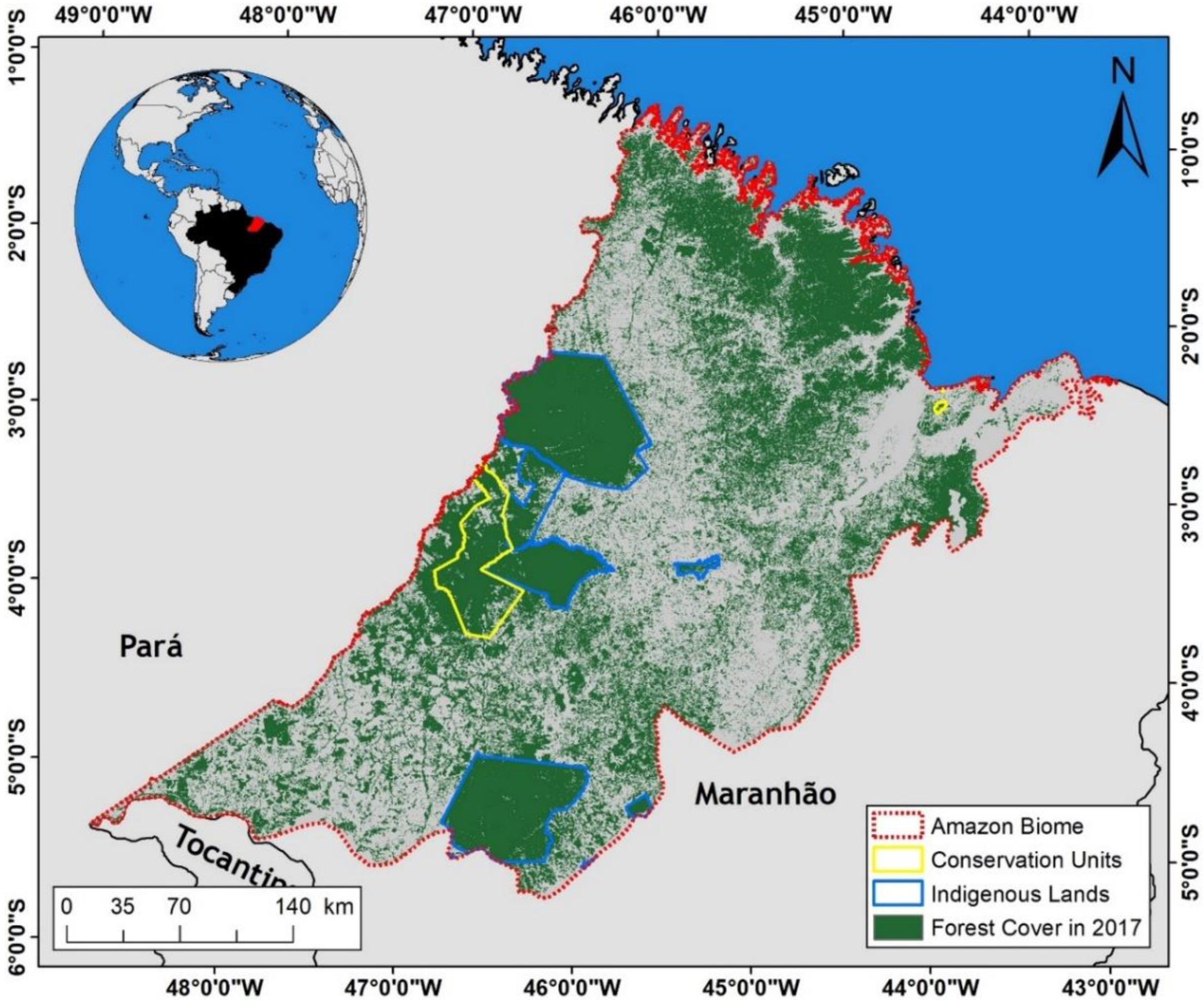

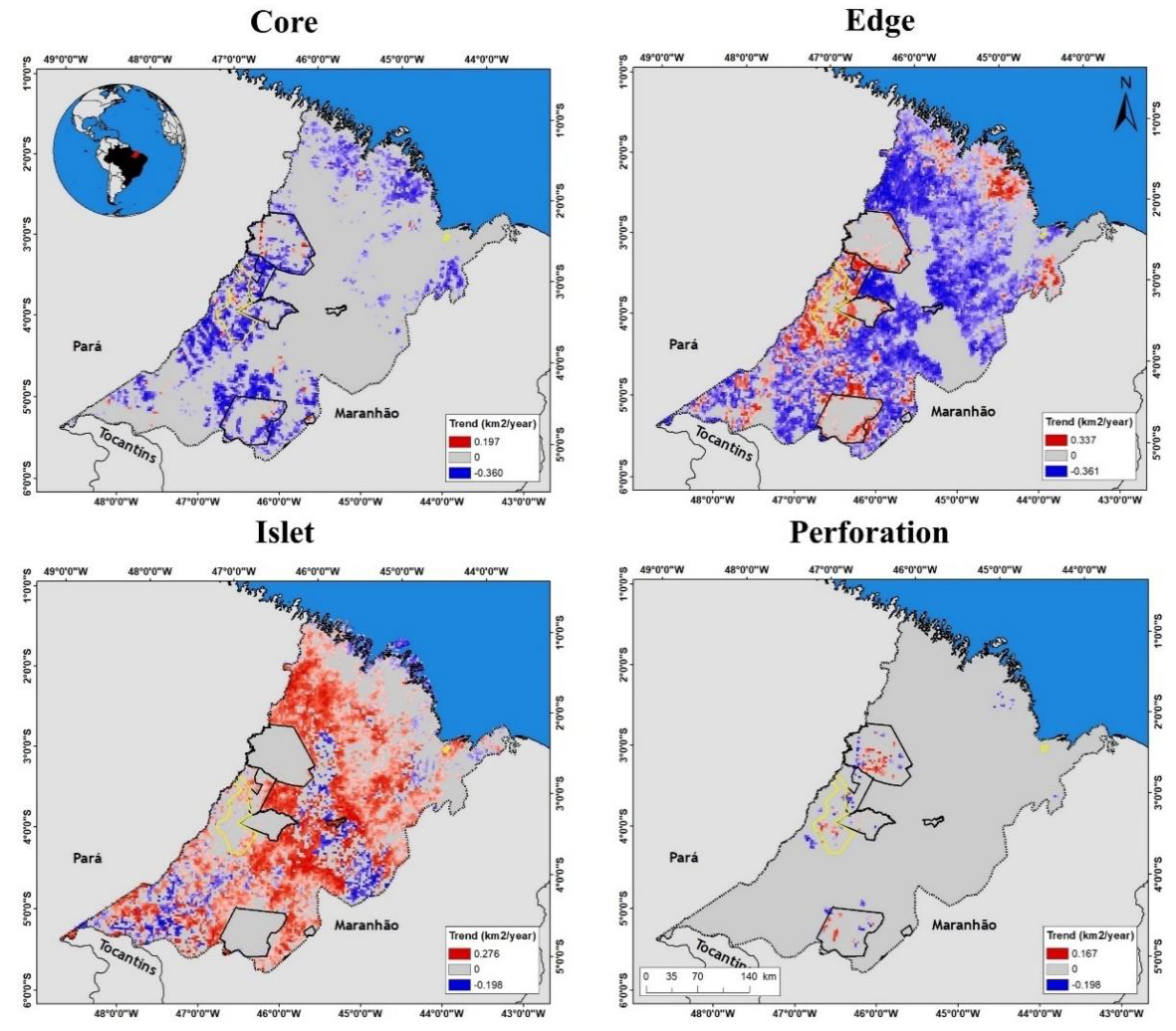
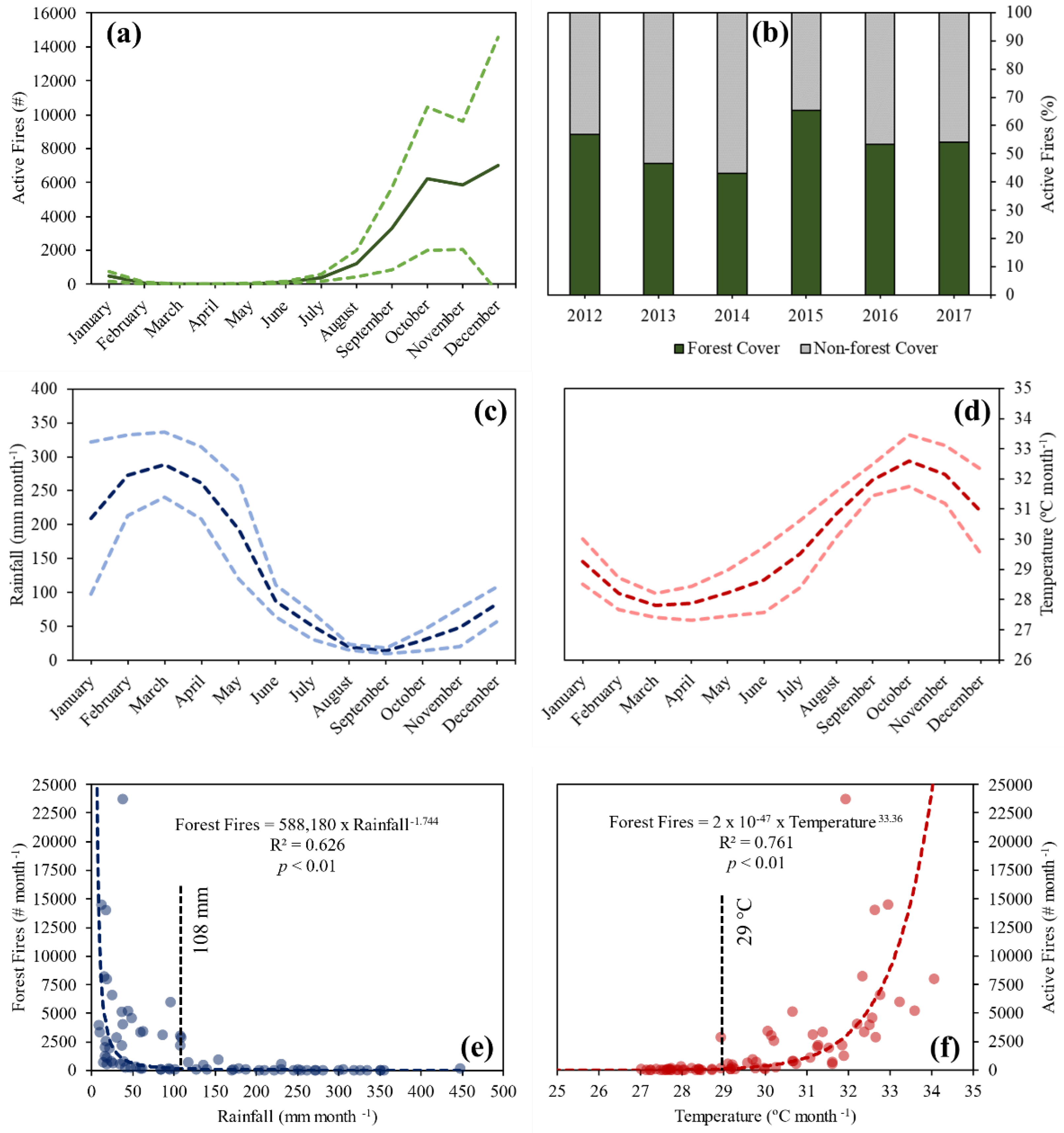
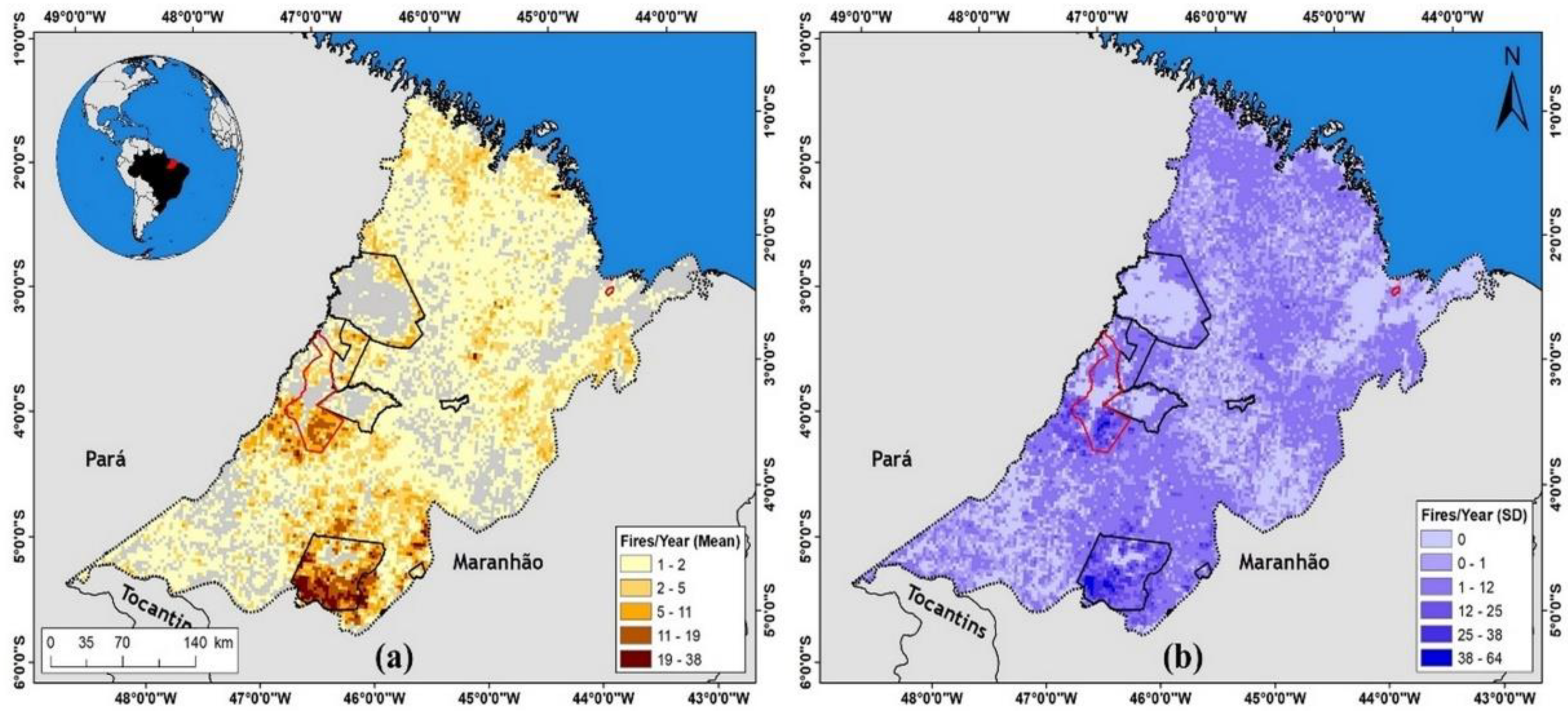
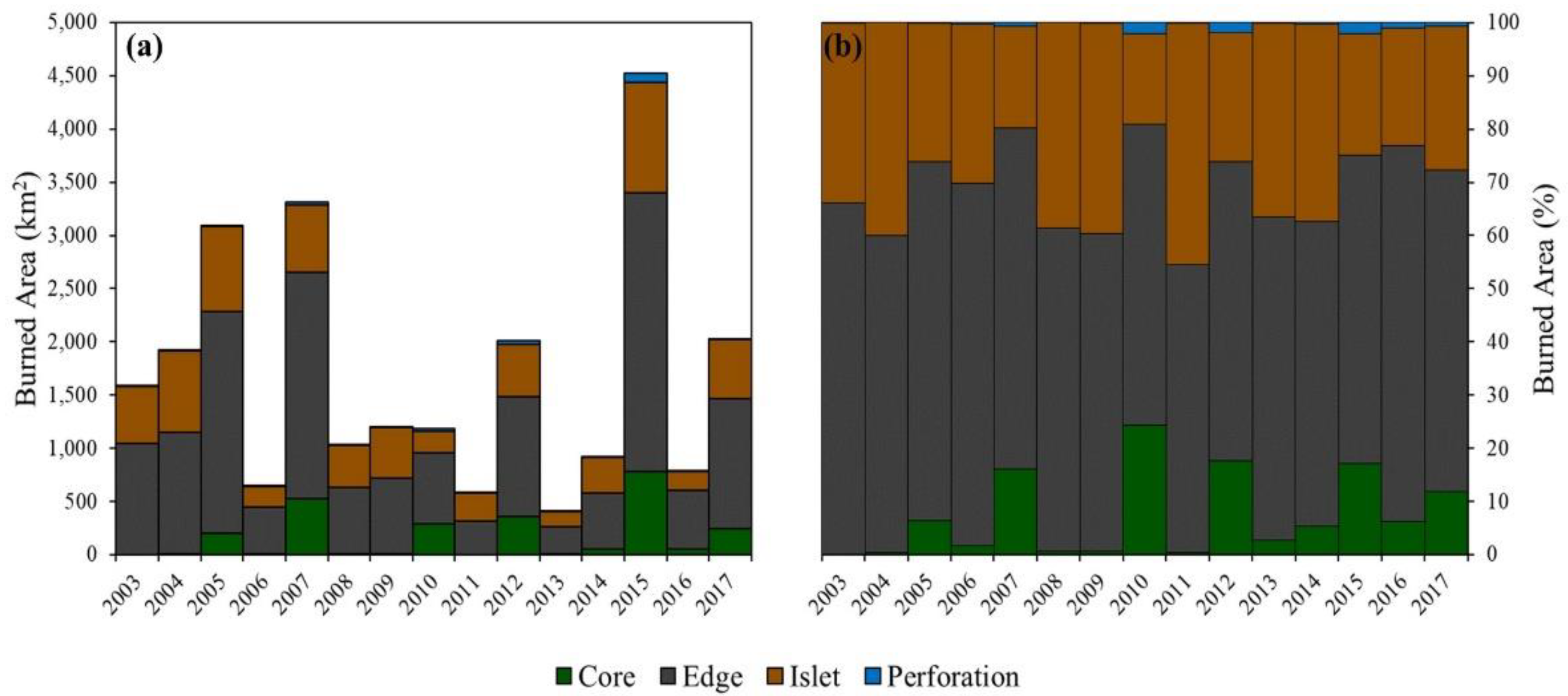
Publisher’s Note: MDPI stays neutral with regard to jurisdictional claims in published maps and institutional affiliations. |
© 2022 by the authors. Licensee MDPI, Basel, Switzerland. This article is an open access article distributed under the terms and conditions of the Creative Commons Attribution (CC BY) license (https://creativecommons.org/licenses/by/4.0/).
Share and Cite
Silva-Junior, C.H.L.; Buna, A.T.M.; Bezerra, D.S.; Costa, O.S., Jr.; Santos, A.L.; Basson, L.O.D.; Santos, A.L.S.; Alvarado, S.T.; Almeida, C.T.; Freire, A.T.G.; et al. Forest Fragmentation and Fires in the Eastern Brazilian Amazon–Maranhão State, Brazil. Fire 2022, 5, 77. https://doi.org/10.3390/fire5030077
Silva-Junior CHL, Buna ATM, Bezerra DS, Costa OS Jr., Santos AL, Basson LOD, Santos ALS, Alvarado ST, Almeida CT, Freire ATG, et al. Forest Fragmentation and Fires in the Eastern Brazilian Amazon–Maranhão State, Brazil. Fire. 2022; 5(3):77. https://doi.org/10.3390/fire5030077
Chicago/Turabian StyleSilva-Junior, Celso H. L., Arisson T. M. Buna, Denilson S. Bezerra, Ozeas S. Costa, Jr., Adriano L. Santos, Lidielze O. D. Basson, André L. S. Santos, Swanni T. Alvarado, Catherine T. Almeida, Ana T. G. Freire, and et al. 2022. "Forest Fragmentation and Fires in the Eastern Brazilian Amazon–Maranhão State, Brazil" Fire 5, no. 3: 77. https://doi.org/10.3390/fire5030077
APA StyleSilva-Junior, C. H. L., Buna, A. T. M., Bezerra, D. S., Costa, O. S., Jr., Santos, A. L., Basson, L. O. D., Santos, A. L. S., Alvarado, S. T., Almeida, C. T., Freire, A. T. G., Rousseau, G. X., Celentano, D., Silva, F. B., Pinheiro, M. S. S., Amaral, S., Kampel, M., Vedovato, L. B., Anderson, L. O., & Aragão, L. E. O. C. (2022). Forest Fragmentation and Fires in the Eastern Brazilian Amazon–Maranhão State, Brazil. Fire, 5(3), 77. https://doi.org/10.3390/fire5030077








